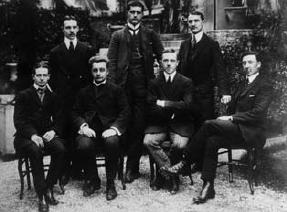ESSEC Business School facts for kids
|
École Supérieure des Sciences Economiques et Commerciales
|
|
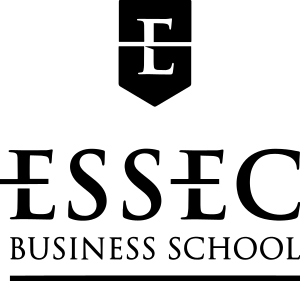
ESSEC Business School
|
|
| Motto | Per scientiam ad libertatem Pioneering spirit Enlighten. Lead. Change. |
|---|---|
| Type | Grande école de commerce et de management (Private research university Business school) |
| Established | 1907 |
| Accreditation | Triple accreditation: AACSB; AMBA EQUIS |
|
Academic affiliation
|
Conférence des Grandes écoles; CY Cergy Paris University |
| President | Vincenzo Esposito Vinzi |
|
Academic staff
|
142 100% PhD.; 36% female; 58% international |
| Students | 5,000 |
| Location | |
| Language | English-only & French-only instruction |
| Colors | White and Black |
ESSEC Business School (which stands for École Supérieure des Sciences Economiques et Commerciales) is a well-known French business school. It's also called a grande école, which is a special kind of higher education school in France.
The main campus of ESSEC is located in Cergy, France. ESSEC also has other campuses in La Défense (near Paris), Rabat in Morocco, and Singapore.
The school was first started by a group called the Jesuits in 1907. It was created to be a different kind of business school. For many years, it worked on its own. Then, in 1981, it became part of the Versailles Chamber of Commerce. Later, in 2013, it joined the Chamber of Commerce and Industry of Paris Île-de-France. Today, ESSEC is part of the CY Alliance, which is a group of schools in the Paris area.
Contents
A Look at ESSEC's History
How ESSEC Began (1907–1913)
ESSEC was founded in 1907 in Paris. It was first called the Economic Institute. It was one of several private business schools started by Catholic groups around that time. These schools wanted to teach business skills along with Christian values.
The school aimed to "train leaders for a commercial and economic career." This meant teaching students to be good business people with strong values. The first school was located in the Latin Quarter of Paris. It started with just seven students, and the program lasted two years. Later, a third year was added as an option.
Students learned about law, accounting, languages, and business techniques. They also had weekly talks about Christian values. The school also included science lessons and visits to factories.
Changes and Growth (1913–1940)
In 1913, the school had to move because of new laws in France. It became part of the Catholic Institute of Paris. This meant the school had fewer resources. For example, it only had one large lecture hall.
During World War I, the school faced tough times. In 1914, it had very few students and closed for a short period. It reopened in 1915. By 1920, things got better, and more than 50 students joined the first year.
In 1923, students created an association to help war widows and orphans. The first list of graduates was published in 1926. By 1930, the number of students grew to 150.
The Great Depression in the 1930s made it hard for ESSEC to attract students. The school had to lower its fees. It also started accepting high school graduates and other students who were not officially certified.
In 1932, the Student Office was created. In 1937, the school started offering scholarships to help students.
New Paths and Programs (1940–1960)
In 1939, the dean, Camille Donjon, changed the school's programs. He introduced entry exams for students. A special class to prepare for these exams was set up in 1941.
Unlike some other business schools, ESSEC chose to keep its own preparatory classes. In 1947, the school's program was extended from two to three years. However, in 1951, ESSEC stopped offering its own prep classes. It opened its exams to students from public preparatory classes. In 1950, a three-month internship was made a required part of the program.
Modernizing ESSEC (1960–1970)
In 1960, Gilbert Olivier became the new dean. He wanted to change the school to keep up with other top schools. He asked students what they thought about the courses. Many students felt the teaching was "scholarly" but "lacked openness."
Based on this feedback, changes were made. Subjects like chemistry and physics were removed. The courses were updated to meet the needs of modern companies. New classes in sociology, human resources, and marketing were added. ESSEC also started using teaching methods popular in U.S. business schools.
The school also became more open. In 1966, it started allowing women to join through a special admission process. However, the preparatory classes still only accepted male students.
Student life also became more active. The "ESSEC Tuesday's" forum was created in 1961. This forum invites famous people from different fields to speak and debate. The "Junior Entreprise" was started in 1967.
The entrance exam was changed in 1969. Chemistry and physics tests were removed. The oral exam focused more on logical thinking and personality.
Moving to Cergy and Financial Challenges (1970–1990)
As more students joined, the school needed more space. In 1967, ESSEC decided to move to a new, larger campus in Cergy-Pontoise. The new campus opened in 1971.
The move was a big change. Some students were not happy because Cergy was harder to reach by public transport. Some teachers worried about the move. The new campus was much bigger. It had many lecture halls, a computer center, a language lab, a library, and sports facilities. Student housing was also built nearby.
Before 1971, most teachers were business executives. But ESSEC started hiring full-time professors. Many of these new professors had studied in the United States. They helped reform the curriculum. A core set of basic courses was set up for the first year. After that, students could choose their own courses. The minimum internship length was increased to 12 months. The number of applicants grew a lot, from 700 in 1960 to 2,800 in 1973.
Building the new campus without public money led to a lot of debt for ESSEC. The school had to pay back millions of francs each year. This meant tuition fees increased, becoming twice as high as some other schools. In 1979, the school faced a big financial crisis.
To save the school, the Versailles Chamber of Commerce stepped in. They gave ESSEC money to cover its debt. They also bought a large part of the school's ownership. In return, ESSEC kept its independence but had a new management system. This agreement was signed in 1981.
ESSEC in the 2000s and Beyond
In 1999, ESSEC decided to call its main program an MBA (Master of Business Administration). This was to show that it met international standards. Other business schools followed this trend.
The school continued to grow its campus. In 2005, the Nautile building was opened. In 2007, the Dome and the Galion were added. The Dome is a large multi-purpose room that can hold 2,700 people. It's used for career fairs, conferences, and exams. The Galion is an administrative and teaching building.
In 2006, ESSEC opened its new campus in Singapore, called the ESSEC Asian Center.
In 2010, ESSEC announced a new plan for 2010–2015. The school changed the name of its MBA program back to MSc in Management. It also aimed to become one of the top 20 business schools in the world.
ESSEC also expanded its partnerships with other universities around the world. These included schools in India, Japan, and the United States.
In 2014, Jean-Michel Blanquer, the new dean, announced the "ESSEC 3I 2020" plan. This plan focused on making the school more international, innovative, and involving students more. A new ESSEC Asia-Pacific campus opened in 2015. An ESSEC Africa campus opened in 2017. The school also started its first online courses (MOOCs) and opened a startup incubator called ESSEC Ventures.
What Students Learn at ESSEC
ESSEC Business School is a grande école. These are very selective schools in France. They admit students through tough exams. Graduates from grandes écoles often get important jobs in government and business in France.
The degrees offered by ESSEC are recognized by the French Ministry of National Education. Higher education degrees in France are organized into three levels: bachelor's, master's, and doctorates. A bachelor's degree usually takes three years, and a master's degree takes two more years.
ESSEC is often mentioned with HEC Paris and ESCP Business School. These three schools are sometimes called the "three Parisians" because they have been important in French business education for a long time.
Research at ESSEC
Research Departments
The school has eight research departments. These departments study different areas of business and human sciences. They include: Accounting, Business Law, Economy, Finance, Management, Operations Management, Marketing, and Information Systems.
CERESSEC Research Center
The ESSEC research center, called CERESSEC, was created in 1969. It is a leading research lab in France for management and related subjects. It helps the school be recognized in national and international rankings. The center has 165 professors working on nine research topics.
ESSEC Iréné Institute
ESSEC Iréné is an institute created in 1996. It focuses on research and education about negotiation, mediation, and solving conflicts. It works with academics, government officials, business leaders, and trade union members.
ESSEC Behavioural Research Lab
This lab studies how people behave in controlled settings. It focuses on areas like how people make decisions when buying things, how they act in management, and how they make choices in economic situations.
How ESSEC is Organized
ESSEC is a non-profit organization. It is managed by a Director General (the School Dean) and an executive committee. This committee includes the deans of different programs and professors. They report to a board that manages the school.
The supervisory board has 28 members. These include representatives from the Paris Ile-de-France Chamber of Commerce, the Catholic Institute of Paris, former students, current students, professors, and administrative staff.
Leaders of ESSEC Business School
| From | To | Name |
|---|---|---|
| 1939 | 1960 | Camille Donjon |
| 1960 | 1980 | Gilbert Olivier |
| 1980 | 1987 | Julien Coudy |
| 1987 | 1988 | Jean-Claude Tournand |
| 1988 | 1989 | Jean Castarède |
| 1990 | 1997 | Jean-Pierre Boisivon |
| 1998 | 2000 | Gérard Valin |
| 2001 | 2013 | Pierre Tapie |
| 2013 | 2017 | Jean-Michel Blanquer |
| 2017 | present | Vincenzo Esposito Vinzi |
ESSEC's Rankings
ESSEC Business School is often ranked among the top business schools in Europe and worldwide. These rankings look at different programs, like undergraduate degrees, master's degrees, and executive education.
| 2016 | 2017 | 2018 | 2019 | 2020 | 2021 | 2022 | |
|---|---|---|---|---|---|---|---|
| FT - European Business School | 18th | 23rd | 8th | 7th | 6th | 8th | 9th |
| Undergraduate - France | |||||||
| Le Point - Classement des Bachelors (France) | 1st | 1st | 1st | 1st | 1st | 1st | 1st |
| L'Étudiant - Classement des Bachelors (France) | 1st | 1st | 1st | 1st | 1st | - | |
| Graduate - Worldwide | |||||||
| FT - Master in Management (Worldwide) | 3rd | 5th | 4th | 3rd | 3rd | 6th | 6th |
| FT - Master in Finance (Worldwide) | 7th | 3rd | 5th | - | 4th | 4th | - |
| QS - Master in Strategy & Management of International Business (Worldwide) | - | 4th | 4th | 3rd | 3rd | 3rd | 3rd |
| QS - Master in Finance (Worldwide) | - | 10th | 9th | 9th | 7th | 7th | 7th |
| QS - Master in Data Sciences & Business Analytics (Worldwide) | - | - | 4th | 3rd | 3rd | 3rd | 4th |
| QS - Master in Marketing Management and Digital | - | - | - | - | - | - | 4th |
| QS - Global MBA (Worldwide) | - | 27th | 26th | 30th | 27th | 27th | 27th |
| Executive - Worldwide | |||||||
| FT - Executive Education Open (Worldwide) | 18th | 24th | 23rd | 21st | 16th | 13th | 12th |
| FT - Executive Education Customised (Worldwide) | 15th | 17th | 12th | 5th | 3rd | - | 5th |
| FT - Executive MBA (Worldwide) | 45th | 47th | 47th | 45th | 32nd | ||
| The Economist - Executive MBA (Worldwide) | - | - | 17th | ||||
| QS - Executive MBA (Worldwide) | - | 7th | 10th | 10th | 8th | ||
ESSEC Campuses Around the World
| ESSEC Business School, Cergy-Pontoise | ESSEC Executive Education at la Defense, Paris | ESSEC Asia-Pacific in Singapore |
|---|---|---|
 |
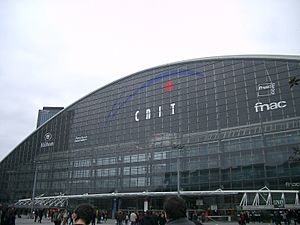 |
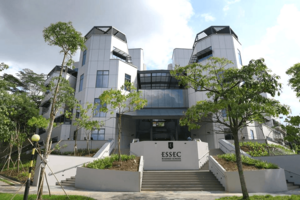 |
ESSEC has four main campuses: Cergy, Singapore, La Défense, and Rabat. A plan for a campus in Mauritius was cancelled in 2017.
Cergy Campus: The Main Hub
The main ESSEC campus is in Cergy. It opened in 1973. This campus is part of the city, so students and local residents mix together. In 2007, two new buildings were added: the Dome and the Galion.
The Dome is a large multi-purpose room that can hold up to 2,700 people. It's used for career fairs, conferences, and exams. The Galion is for administration and teaching. It has offices, meeting rooms, lecture halls, and classrooms.
A project called "Campus 2020" was announced in late 2018. It aims to modernize the Cergy campus by 2023. This project includes building a new sports center and updating existing buildings for research.
La Défense Campus: For Professionals
ESSEC has had a campus in La Défense (a business district near Paris) since 1989. This campus is mainly used for continuing education and MBA programs for working professionals.
Singapore Campus: Gateway to Asia
The ESSEC Asia-Pacific campus in Singapore was announced in 2012 and opened in May 2015. ESSEC has been active in Asia since 1980. The school chose Singapore because it's a great place to connect with the rest of Asia.
The campus is located on Nepal Hill. It covers a large area and can host 1,500 students each year. It was designed by a famous Singaporean architect, Dr. Liu Thai Ker.
Rabat Campus: In North Africa
The campus in Rabat, Morocco, was announced in 2015 and opened in April 2017. Morocco was chosen because ESSEC's partner school, CentraleSupélec, was already there. It's also close to France and has many ESSEC alumni.
The campus is about 15 km from Rabat. It covers 6,000 square meters and can hold 480 students. It was built specifically for ESSEC. When it first opened, it had seventy students.
Programs Offered at ESSEC
ESSEC Global BBA: For High School Graduates
The Global BBA is an undergraduate program that lasts four years. It's designed for students who have just finished high school. The program helps students prepare for international business careers.
Students in this program spend at least 12 months studying abroad. They also complete a one-month humanitarian project. Plus, they gain 11 to 18 months of work experience, which can also be abroad.
Master in Management - Grande École Program
ESSEC's Master in Management (also called the "Grande École program") is for students who don't have much work experience yet. It's the main program of the school.
Historically, this program was for students who completed special French preparatory classes after high school. These students take a very competitive entrance exam. Now, students from other countries with a university degree can also apply.
The program allows students to choose their own path. They can take courses at ESSEC or at partner schools. They can also study abroad or work on student projects.
Master in Finance
The Master in Finance program replaced an older finance master's degree in 2016. It is recognized as a master's degree by the French Higher Education Ministry.
Students can choose one of three specializations:
- Corporate Finance: This focuses on things like mergers, buying and selling companies, and managing company money.
- Financial Markets: This covers trading, managing risks, and handling investment portfolios.
- FinTech & Analytics: This is for students with strong math or physics backgrounds. It deals with using data and technology in finance.
ESSEC M.S. Advanced Masters
These are specialized master's degrees. They are for students who have finished their studies or young professionals. These programs help them add new knowledge to their existing skills, often in science or engineering.
ESSEC Global MBA
The Global MBA at ESSEC is a 12-month, full-time program. It focuses on growing markets and hands-on learning. Students can choose to specialize in Luxury Brand Management or Strategy and Digital Leadership.
PhD in Business Administration
The PhD program trains future professors, researchers, and consultants. Students first take two years of courses and seminars. After that, they work on their research project, called a dissertation.
ESSEC Executive Education
More than 5,000 managers take part in ESSEC's Executive Education programs each year. These programs are mainly held at the La Défense campus in Paris and the Singapore campus.
ESSEC & Mannheim Executive MBA
ESSEC and Mannheim Business School started a joint Executive MBA program in 2004. This program has modules in Mannheim, Paris, Singapore, and other locations around the world.
International Connections
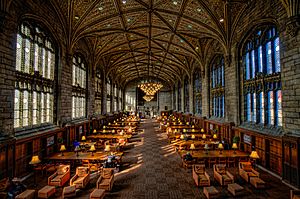
ESSEC has many exchange and double-degree programs with universities worldwide. Some of these include: UC Berkeley, University of Chicago, Dartmouth College, Cornell University, Peking University, Tsinghua University, Seoul National University, Keio University, National University of Singapore, and IIM Ahmedabad.
Famous People from ESSEC
The ESSEC Alumni group was founded in 1923. It represents over 60,000 graduates from ESSEC. These alumni live in 75 countries across five continents. The group organizes many events each year.
Since 2017, the alumni association has an office on the Cergy campus. Also, since 2017, becoming a lifelong member of ESSEC Alumni is included in the tuition fees.
Notable Alumni
Business Leaders
- Nicolas Hieronimus, CEO of L'Oréal Group
- Sue Nabi, CEO of Coty Inc.
- Marc Lelandais, Chairman of S. T. Dupont
- Benoît Coquart, CEO of Legrand
- Olivier Sichel, Deputy CEO of Caisse des dépôts et consignations
- Véronique Bédague, CEO of Nexity
- Antoine Bernard de Saint-Affrique, CEO of Danone
- Michel Bon, former CEO of Carrefour and France Telecom
- Patrick Cescau, former CEO of Unilever
- Pierre-André de Chalendar, CEO of Saint-Gobain
- Corinne Vigreux, Co-founder of TomTom N.V.
- Nicolas Namias, CEO of Group BPCE
- Pierre Nanterme, former CEO of Accenture
- Yves Perrier, CEO of Amundi
- Pierre Denis, CEO of Jimmy Choo (fashion house)
- Marie-Christine Lombard, CEO of TNT Express
- Dominique Reiniche, former CEO of Coca-Cola Europe
- Gilles Pélisson, CEO of TF1
- Charles Bouaziz, CEO of Monoprix S.A.
- Élisabeth Moreno, former President of Hewlett-Packard Africa
- Thierry Peugeot, Chairman of the Supervisory Board of Peugeot-Citroën
- Jérôme Tafani, CEO of Burger King France
Political Figures
- Charles Konan Banny, former Prime Minister of Ivory Coast
- Oumar Tatam Ly, former Prime Minister of Mali
- Cécile Duflot, former French Minister of Housing
- Fleur Pellerin, former French Minister of Culture
- Emmanuelle Mignon, former Cabinet secretary for French President Nicolas Sarkozy
- Alexis Kohler, Chief of Staff for President of France Emmanuel Macron
Academics
- D. K. Bandyopadhyay, Indian researcher in scientific management
Other Well-Known Alumni
- Gérald Caussé, Presiding Bishop of The Church of Jesus Christ of Latter-day Saints
- Marie-José Pérec, former sprinter and Olympic champion
- Philippe Sollers, French writer
See also
 In Spanish: Escuela Superior de las Ciencias Económicas y Comerciales para niños
In Spanish: Escuela Superior de las Ciencias Económicas y Comerciales para niños
- Chamber of Commerce and Industry of Paris
- HEC Paris
- ESCP Business School
- Triple accreditation


